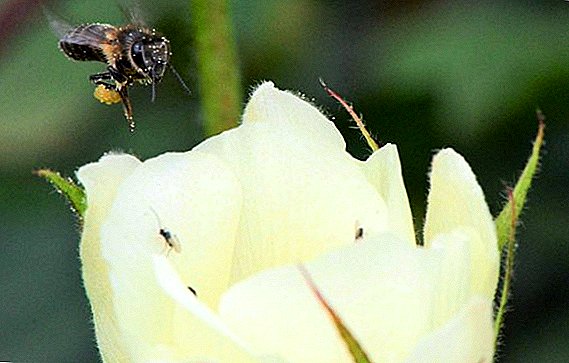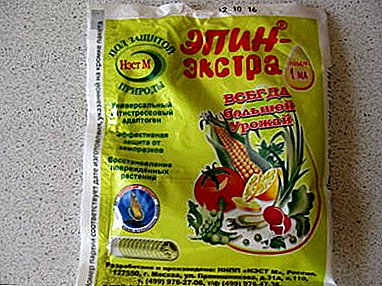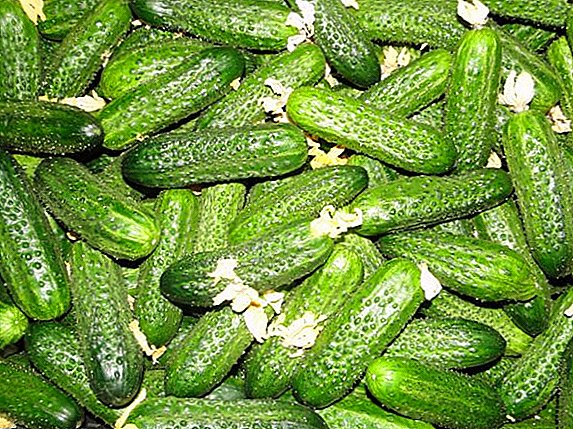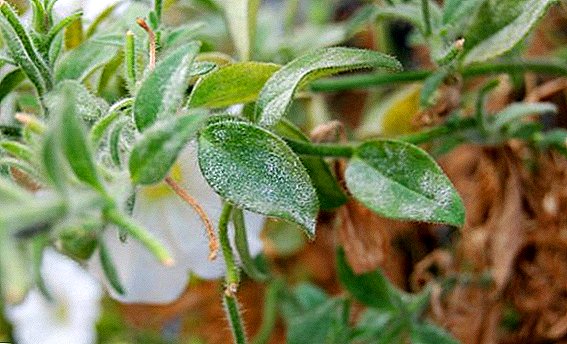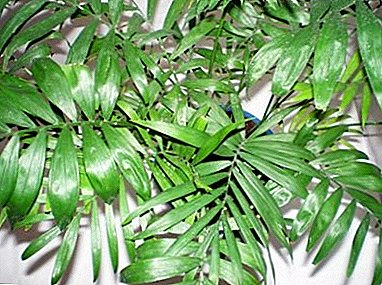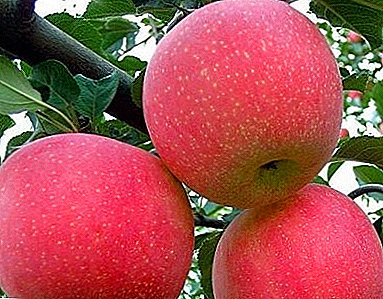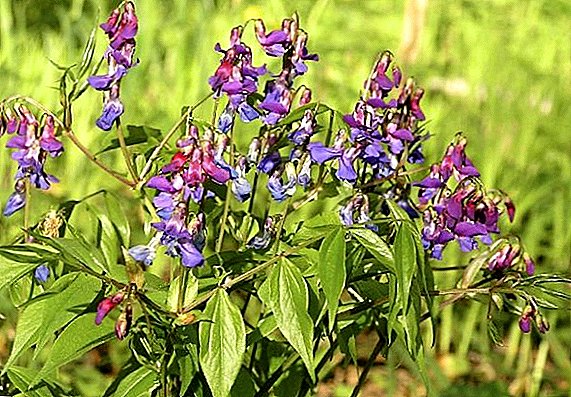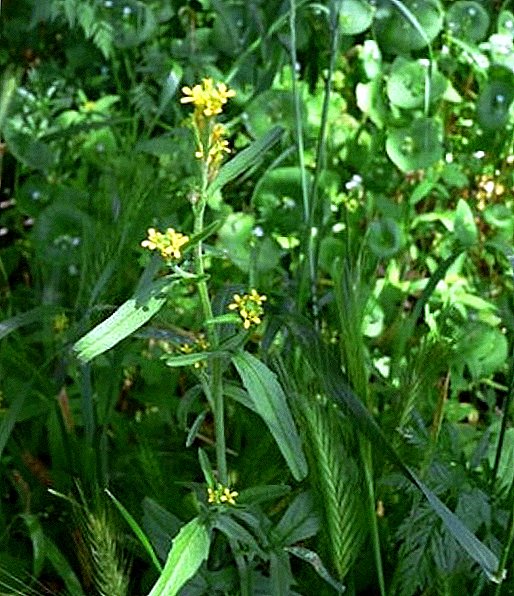 Goulavnik medicinal - The herbaceous plant is distributed quite widely in the temperate climatic zone, however not many have discovered for themselves all the benefits of this species for medicine and human economic activity. In this article we will determine what benefit a walker can bring us in everyday life and how to properly prepare it.
Goulavnik medicinal - The herbaceous plant is distributed quite widely in the temperate climatic zone, however not many have discovered for themselves all the benefits of this species for medicine and human economic activity. In this article we will determine what benefit a walker can bring us in everyday life and how to properly prepare it.
History reference
Guliavnik refers to those plant species that are known to man since ancient times. Many centuries ago, our ancestors used its healing properties. At this time, the most popular was the sap of the plant, it was actively used by many singers and speakers in order to enhance the voice, give it power and sonority.  In addition, herb derivatives have been actively used as the best means for restoring the activity of the vocal cords, impaired by various factors.
In addition, herb derivatives have been actively used as the best means for restoring the activity of the vocal cords, impaired by various factors.
Did you know? The well-known arugula is nothing more than a domesticated variety of drug walking, which was bred during the times of ancient Rome.
Over the centuries, the popularity of the species only increased, the fever and fever were actively treated with a walker, and during the Renaissance in France and England many court ladies used it in cosmetology. Derived plants were believed to be able to rejuvenate the skin and make it silky.
The peasants used this herb for the treatment of various ailments, as well as in cooking for preparing various soups and salads. In addition, the plant used to treat diseases associated with loss of voice.
The Tibetan monk was also a popular species. It was actively used by the inhabitants of the mountain peaks since time immemorial for the treatment of various food poisonings. Until the beginning of the 20th century, the pepperer was actively used for medicinal purposes and as food, but in modern times its significance has quite noticeably decreased. The revival of fashion for this plant occurred relatively recently, only a few decades ago. 
Botanical description
Medicator (Sisymbrium officinale) is a herb that belongs to the cruciferous family. Stem in representatives of the species is upright, branched, dotted with short hairs over the entire surface.
Did you know? Today, world science knows about 320 thousand of all kinds of plants, but about 21 thousand have a medicinal effect, which is about 6.5%.
The height of the stem is about 30-60 cm. The leaves of the plant are heterogeneous. In the upper part they are sessile, small, with a spear-shaped, arrow-shaped or lanceolate leaf blade. Lower leaves are cherenkovye, with leaf-pinnately dissected leaf plate, irregular teeth and triangular apical lobes.
The flowers in representatives of the species are predominantly small, often they gather in a spike-shaped brush. Sepals are straight, petals oblong-oval, have a nail. Flowers predominantly yellow shades. The species often blooms throughout May and June. After flowering, at the end of August, fruit-pods ripen on the walker, which fit snugly to the twigs. In the pods ripen small reddish-brown seeds, about 2 mm long. 
Spread
Distributed this plant in a temperate climate zone everywhere. Therefore, it can be found on the territory of North Africa, Europe, America, in the European part of Russia, in Siberia and in the Far East. Often grows a walk along roads and fences, on fields, not improved land plots, etc.
Did you know? The first Russian-language reference book on medicinal herbs in our geographical zone was created by the Russian scientist Andrei Bolotov in 1781. The publication was called "Guide to the knowledge of medicinal herbs."
Chemical composition
The chemical composition of this species is quite rich. A detailed analysis revealed that the spider contains the following substances and compounds: corcoroside A, gelvetikosid, thioglycosides, flavonoids, sulfur, ascorbic and oleic acids, carotene, tannins.
The seeds of this herb are also rich in a whole complex of beneficial compounds, which include: vitamin C, mustard oil, eicozenic, palmitic, oleic and arachnic acids. In addition, it is worth mentioning the presence in the plant of many important trace elements, among which the largest number is occupied by: calcium, ferum, magnesium, manganese, potassium, phosphorus and zinc. 
Beneficial features
The main beneficial properties of the medicinal drug are explained by its rich composition. A variety of extracts and components of the plant can have an astringent and diuretic effect on the body.
Preparations from such plants as: mordovnik, juniper, bathing vessel, goldenrod, stonecrop large, spurge, safflower and chervil are also often used as a diuretic.
But the most common type of home medicine is used to combat a variety of colds as an expectorant.
The plant has also proven itself as an anti-inflammatory, antibacterial and wound-healing agent as part of a variety of fees and extracts.
Do not forget about the presence in the composition of the man of vitamin C, which has a high antiscorbutic effect, as well as glycoside sinigrin, which is famous for its beneficial effect on the activity and condition of the heart muscle.
Application
The main areas of active use of a joyful in economic activity are medicine and cooking. It is in these industries that the complex of highly active compounds that successfully combines in a plant is most successfully used. 
In medicine
A variety of inflammatory and infectious diseases of the respiratory system, including asthma, bronchitis, laryngitis and even tuberculosis, are treated with broths and infusions from a funwalk. Excellently proven such drugs and in the fight against diseases of the digestive system (loss of appetite, gastritis), to eliminate inflammatory diseases of the urinary system (urethritis, pyelonephritis, prostatitis and cystitis of various etiologies).
Favorable digestive tract also affects: herb bison, cress, calendula, oregano (oregano), meadow sage, Kale cabbage, Lyubka two-leaved, yucca, dodder and anise.
In addition, the walker is able to have a powerful antibacterial and wound-healing effect, so this plant is actively used in the fight against dermatitis and skin lesions in the oral cavity. It is also able to overcome cough, dysentery and helminthic affection, as well as restore the general protective functions of the body.
In cooking
For the preparation of various dishes, the walker is not used as actively as in medicine, however, many lovers of exquisite dishes especially appreciate the plant for its delicate mustard flavor.  Therefore, fresh seasonal salads based on it are an excellent alternative to many varieties of greens.
Therefore, fresh seasonal salads based on it are an excellent alternative to many varieties of greens.
Important! It is not worth eating for food purposes a hand-picked collected drug walker, as there is an opportunity to confuse the species with related plants, which often have potent toxic toxins.
In the cold season, dried billet blanks become especially popular as a fragrant condiment for a variety of meat and fish dishes. Sometimes fresh leaves of this plant species are used for fermentation or pickling, after which such product is served as a side dish to vegetables or meat. Well, the seeds of the plant have found their use in the preparation of a variety of mustard sauces.
Collecting and harvesting
Despite the fact that the active growing season of this medicinal species is observed throughout the entire warm period of the year, the collection of medicinal raw materials should be dealt with exclusively during the period of active flowering, which falls on the summer months.
The ground part of the plant is cut, for this you can use any cutting object (knife, sickle, etc.). Leaves, flowers, pods and even stems are suitable for harvesting.  They dry the raw materials by laying out the plant parts on a clean cloth or paper in a dry, warm and ventilated place (shed or special attic) in a natural way, without access to direct sunlight. To obtain a uniform effect during the drying process, the raw materials should be constantly mixed.
They dry the raw materials by laying out the plant parts on a clean cloth or paper in a dry, warm and ventilated place (shed or special attic) in a natural way, without access to direct sunlight. To obtain a uniform effect during the drying process, the raw materials should be constantly mixed.
Important! During harvesting plants for medicinal purposes, be sure to remember that the seeds should be harvested only after they are fully matured, since the unripe seeds contain toxic compounds.
The shelf life of such a billet is no more than one year, however, the raw parts of the walker are considered the most valuable, since in the process of drying and storage it loses its positive qualities.
Storage conditions
The stockpile is stored in metal or glass containers with the lid tightly closed. In this case, the workpiece should be protected from direct sunlight, humidity and temperature above +25 ° C. You can save the plant in frozen form, for this it is thoroughly washed, dried and packed in small plastic bags. Such preparations are stored at a temperature of -5 ... 0 ° С for no more than 12 months.
Possible harm and contraindications
Despite its high beneficial effect on the body, grass is a number of contraindications and special recommendations for use. Refuse or limit the use of such funds should be with pyelonephritis or hypertension in the period of exacerbation of the disease, as this may aggravate the general condition of the body.  The remedy is also contraindicated in children under 16 years of age, since in childhood this can harm the poor health of the child.
The remedy is also contraindicated in children under 16 years of age, since in childhood this can harm the poor health of the child.
Important! To use the goulavnik for medicinal purposes should be exclusively in the established prescription standards, otherwise it may cause a disturbance of the cardiac activity and the general rhythm of the heart.
Cooking infusion
Infusions of the medicinal guljavnik perfectly proved to eliminate the pathologies associated with the loss of voice, bronchitis and cystitis. To prepare such a preparation, 1 tablespoon of dry, finely chopped raw material is drawn into 300 ml of boiling water for 2 hours, and then filtered.
Use medication 5 times a day and 1 tablespoon. To improve its effectiveness, the broth can be enriched with a tablespoon of honey. When sore throat 2 tablespoons of herbs insist in 300 ml of boiling water to cool completely. The cooled mixture is filtered and applied to 1 tablespoon 3 times a day. 
Cooking broth
Broths from this medicinal plant help to cope with the development of ailments associated with the deterioration of the digestive tract. To do this, 20 g of dry, finely chopped raw material is poured 250-300 ml of boiling water, after which the mixture is boiled for 15 minutes in a water bath, and after cooling it is carefully filtered. For therapeutic purposes, this drug is taken in 1/3 cup 3 times a day after meals.
In case of inflammatory diseases of the respiratory system, decoctions are prepared from seeds. To do this, 10 g of seeds of the plant is poured 300 ml of boiling water and boil in a water bath for 20 minutes.
Use this tool 2 tablespoons 3 times a day. To improve the taste, an infusion is recommended to sweeten with sugar.
We advise you to read about the benefits and harms of medicinal herbs: coltsfoot, lemon balm, peppermint, St. John's wort, wormwood and healing, immortelle, ginseng.
Medicare is an excellent alternative to many potent chemicals. Different infusions and decoctions of this plant make it possible to give a decisive battle to many pathologies of organs and systems.
However, the use of extracts of this plant should be with extreme caution, since an overdose of a bobber can cause serious disturbances of the activity of the heart and related illnesses. But with proper observance of the above recommendations, this plant species will help get rid of many ailments and related problems.


